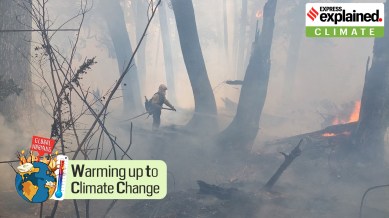Warming up to climate change: What are climate tipping points?
In this series of explainers, we answer some of the most fundamental questions about climate change, the science behind it, and its impact. In the sixth instalment, we answer the question: ‘What are climate tipping points?'

There is no dearth of reports highlighting the consequences of climate change, including droughts, water scarcity, severe wildfires, rising sea levels, etc. Despite that, there are many myths and a lot of confusion around the subject.
In this series of explainers, we answer some of the most fundamental questions about climate change, the science behind it, and its impact. In the sixth instalment (you can scroll down to the end of this article for the first five parts), we answer the question: ‘What are climate tipping points?’
What are climate tipping points?
Climate tipping points are essentially critical thresholds beyond which a natural system can tip into an entirely different state and cause irreversible and disastrous consequences for the planet, including more warming.
For example, rising global temperatures can trigger a change like a rainforest becoming a dry savannah. “This change is propelled by self-perpetuating feedback loops, even if what was driving the change in the system stops. The system – in this case the forest – may remain ‘tipped’ even if the temperature falls below the threshold again,” according to a report by the European Space Agency.
Moreover, breaching one tipping point can increase the likelihood of crossing others — triggering a catastrophic domino effect. For instance, unabated global warming can cause irreversible ice melt from the Greenland ice sheet. This could slow down the ocean’s circulation of heat, the Atlantic Meridional Overturning Circulation (AMOC), which, in turn, could impact South America’s monsoon system. Changes in the monsoon system may lead to a rise in the frequency of droughts in the Amazon rainforest, the ESA report noted.
Over the years, scientists have identified a host of different climate tipping points across the Earth system. According to the ESA report, they largely fall into three broad categories — cryosphere, ocean-atmosphere, and biosphere — and range from the melting of the Greenland ice sheet to the death of coral reefs.
Are we close to breaching any of the climate tipping points?
In December 2023, the Global Tipping Points Report, led by Professor Tim Lenton from the University of Exeter’s Global Systems Institute with the support of more than 200 researchers from over 90 organisations in 26 countries, was published.
The report identified and examined more than 25 climate tipping points. It revealed: “Five major tipping points are already at risk of being crossed due to warming right now and three more are threatened in the 2030s as the world exceeds 1.5C global warming.”
Currently, as Earth has become 1.1 degree Celsius warmer than pre-industrial levels, the tipping points at risk are the collapse of big ice sheets in Greenland and the West Antarctic, the widespread thawing of permafrost, the death of coral reefs in warm waters, and the collapse of one oceanic current in the North Atlantic.
Once the planet passes the 1.5 degree Celsius threshold, tipping points, including the death of boreal forests, mangroves, and seagrass meadows, will potentially be breached.
The report added that crossing these tipping points could have a catastrophic impact on societies, with the potential to “escalate violent conflicts, mass displacement and financial instability”.
How can we avoid breaching tipping points?
The best way to limit the risk of passing climate tipping points is to curb greenhouse gases. However, the world has not been able to do so far. In 2023, greenhouse gas concentrations in the atmosphere reached the highest levels ever recorded in the atmosphere, according to the latest data by C3S and the Copernicus Atmosphere Monitoring Service (CAMS).
While carbon dioxide concentrations last year were 2.4 parts per million (ppm) higher than in 2022, methane concentrations increased by 11 parts per billion (ppb).
“Global governance is currently inadequate to minimise tipping point threats and to do so equitably,” the Global Tipping Points Report noted. It also added that by the time an adequate global emergency action would be implemented, some of the climate tipping points may still be crossed.
This series has answered questions on the warming of Earth and humans’ role in climate change and explained some other fundamental issues related to our changing environment. You can click to read the previous parts: Part 1, Part 2, Part 3, Part 4, and Part 5.